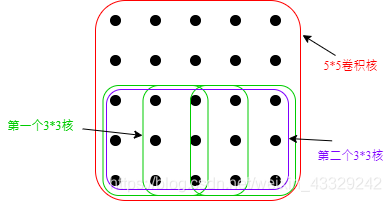Backbone-VGG
1.介绍
VGG于2014年由牛津大学科学工程系Visual Geometry Group组提出的,作者在《Very Deep Convolutional Networks for Large-Scale Image Recognition》的abstract中提到,相比于2012年的AlexNet,VGG采用了多个小的卷积(3*3)核来代替AlexNet中的大卷积核(11*11和5*5)。
对于给定的感受野(与输出有关的输入图片的局部大小),采用堆积的小卷积核是优于采用大的卷积核,这个很难用来理论解释,感性认识是,小卷积核加上激活函数属于非线性变换,多层非线性变换会比一层变换得到的特征更具有表达性,而且代价还比较小(参数更少)。简单来说,在VGG中,使用了3个3x3卷积核来代替7x7卷积核,使用了2个3x3卷积核来代替5*5卷积核,这样做的主要目的是在保证具有相同感知野的条件下,提升了网络的深度,在一定程度上提升了神经网络的效果。
比如,3个步长为1的3x3卷积核的一层层叠加作用可看成一个大小为7的感受野(其实就表示3个3x3连续卷积相当于一个7x7卷积),其参数总量为 3x(9xC^2) ,如果直接使用7x7卷积核,其参数总量为 49xC^2 ,这里 C 指的是输入和输出的通道数。很明显,27xC^2小于49xC^2,即减少了参数;而且3x3卷积核有利于更好地保持图像性质。
这里解释一下为什么当stride为1时,使用2个3x3卷积核可以来代替5*5卷积核。代替的意思是两者的感受野相同,下图很形象的解释了这个过程。绿色框卷积之后会形成相邻的三个像素,这三个像素会被一个紫色卷积核全部感受到。

2.网络结构
论文的第三页给出了网络的结构图。其中D列代表VGG16,E列代表VGG19,相比16多了三个卷积层。conv3-64代表着卷积核大小为3*3,共有64个卷积核。

下面是VGG16的结构图(网络上的图),很容易与上图D列相对应,这里就不过多阐述了。原先这里有个问题挺疑惑,上图中没有写maxpool的尺寸和各个层的尺寸,下面的的图中各层尺寸是如何得知的呢?再看论文发现,The convolution stride is fixed to 1 pixel; the padding is 1 pixel for 3 × 3 conv ;Max-pooling is performed over a 2 × 2 pixel window, with stride 2 . 这样就对了,卷积核3*3且padding为2时,输出尺寸不变;max-pooling输出长宽缩小为输入的1/2,没有问题。此外,论文中写到All hidden layers are equipped with the rectification (ReLU (Krizhevsky et al., 2012)) non-linearity ,即所有隐藏层都加Relu。

- 输入224x224x3的图片,经64个3x3的卷积核作两次卷积+ReLU,卷积后的尺寸变为224x224x64
- 作max pooling(最大化池化),池化单元尺寸为2x2(效果为图像尺寸减半),池化后的尺寸变为112x112x64
- 经128个3x3的卷积核作两次卷积+ReLU,尺寸变为112x112x128
- 作2x2的max pooling池化,尺寸变为56x56x128
- 经256个3x3的卷积核作三次卷积+ReLU,尺寸变为56x56x256
- 作2x2的max pooling池化,尺寸变为28x28x256
- 经512个3x3的卷积核作三次卷积+ReLU,尺寸变为28x28x512
- 作2x2的max pooling池化,尺寸变为14x14x512
- 经512个3x3的卷积核作三次卷积+ReLU,尺寸变为14x14x512
- 作2x2的max pooling池化,尺寸变为7x7x512
- 与两层1x1x4096,一层1x1x1000进行全连接+ReLU(共三层)
- 通过softmax输出1000个预测结果
3.代码实现
import torch.nn as nn
import torch
class VGG(nn.Module):
def __init__(self, num_classes=1000):
super(VGG, self).__init__()
self.features = nn.Sequential(
nn.Conv2d(3, 64, kernel_size=3, stride=1, padding=1),
nn.ReLU(inplace=True),
nn.Conv2d(64, 64, kernel_size=3, stride=1, padding=1),
nn.ReLU(inplace=True),
nn.MaxPool2d(kernel_size=2, stride=2),
nn.Conv2d(64, 128, kernel_size=3, stride=1, padding=1),
nn.ReLU(inplace=True),
nn.Conv2d(128, 128, kernel_size=3, stride=1, padding=1),
nn.ReLU(inplace=True),
nn.MaxPool2d(kernel_size=2, stride=2),
nn.Conv2d(128, 256, kernel_size=3, stride=1, padding=1),
nn.ReLU(inplace=True),
nn.Conv2d(256, 256, kernel_size=3, stride=1, padding=1),
nn.ReLU(inplace=True),
nn.Conv2d(256, 256, kernel_size=3, stride=1, padding=1),
nn.ReLU(inplace=True),
nn.MaxPool2d(kernel_size=2, stride=2),
nn.Conv2d(256, 512, kernel_size=3, stride=1, padding=1),
nn.ReLU(inplace=True),
nn.Conv2d(512, 512, kernel_size=3, stride=1, padding=1),
nn.ReLU(inplace=True),
nn.Conv2d(512, 512, kernel_size=3, stride=1, padding=1),
nn.ReLU(inplace=True),
nn.MaxPool2d(kernel_size=2, stride=2),
nn.Conv2d(512, 512, kernel_size=3, stride=1, padding=1),
nn.ReLU(inplace=True),
nn.Conv2d(512, 512, kernel_size=3, stride=1, padding=1),
nn.ReLU(inplace=True),
nn.Conv2d(512, 512, kernel_size=3, stride=1, padding=1),
nn.ReLU(inplace=True),
nn.MaxPool2d(kernel_size=2, stride=2),
)
self.classifier = nn.Sequential(
nn.Linear(512 * 7 * 7, 4096),
nn.ReLU(inplace=True),
nn.Dropout(),
nn.Linear(4096, 4096),
nn.ReLU(inplace=True),
nn.Dropout(),
nn.Linear(4096, num_classes),
nn.ReLU(inplace=True),
nn.Softmax(dim=1),
)
def forward(self, x):
x = self.features(x)
x = x.view(x.size(0), 512 * 7 * 7)
x = self.classifier(x)
return x
if __name__ == '__main__':
# Example
net = VGG()
x = torch.rand(1, 3, 224, 224)
out = net.forward(x)
print(out.size())
4.心得
- 关于nn.SoftMax中dim的理解
- 发现一种很简介的网络结构定义方法
- python的一些特性
def foo(a, b, c):
return a+b+c
if __name__ == '__main__':
a = [1,2,3]
print(foo(*[1,2,3])) # 这两种表达是一样的
print(foo(1,2,3))
-
这个用法在2中用到了,文中在创造类的实例时用的。**kwargs可能是为了重写num_classes和init_weights用的吧。
model = VGG(make_layers(cfg['A']), **kwargs)class VGG(nn.Module): def __init__(self, features, num_classes=1000, init_weights=True): super(VGG, self).__init__() self.features = features ......